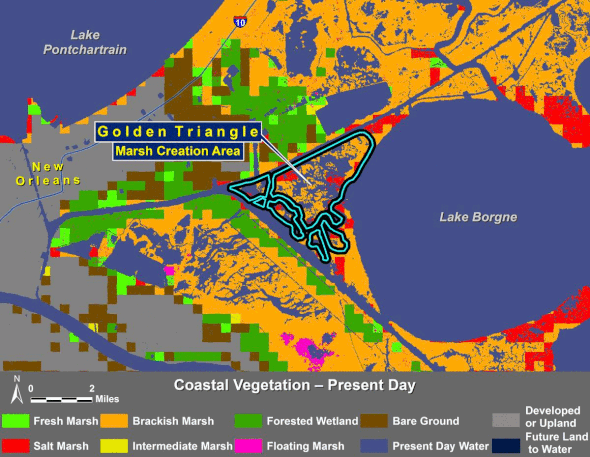This Wetland Restoration Project Will Help Keep the Gulf out of New Orleans
To restore Louisiana’s coast, we need a suite of large-scale restoration projects across the coast working together to deliver maximum benefits to reduce land loss, restore ecosystems, and maintain healthy and diverse habitat. In our “Restoration Project Highlights” series, we take a deeper look at specific projects from our list of Priority Projects, highlighting why they’re needed and hearing local perspectives on importance.
*This blog was updated on 05/14/2022 to reflect current project status
What is the Golden Triangle?
More people know the Golden Triangle for its role in history rather than for its name. These roughly 4,000 acres of wetlands adjacent to New Orleans are home to the bayous the British traversed in 1814 just before the Battle of New Orleans. It is also the site of the infamous “funnel” where the Mississippi River Gulf Outlet (MRGO) and Gulf Intracoastal Waterway converge. This funnel created a catastrophic surge effect during the Hurricane Katrina in 2005, causing levees and floodwalls to collapse and unleashing a deadly wall of water into communities in the Lower 9th Ward, New Orleans East, and St. Bernard Parish. In the aftermath of this destruction, a 1.8 mile surge barrier was built for $1.3 billion—the largest design-build project in Army Corps history—in order to reduce future storm surge and better protect communities in the future.
Why is the Golden Triangle Marsh Creation Project Important?
The 4,420 acre Golden Triangle Marsh provides a wetland buffer along urban areas of New Orleans, but it has been sliced and diced by a little used navigation channels, flood walls and oil and gas canals. The channels, walls and canals not only destroyed wetlands, but also allowed salt water to permeate the marsh and create a recipe for immense land loss. A restored marsh is an important investment in the funnel area, in particular, because it will help support a critical part of the levee system that surrounds New Orleans. Though it’s a $1.3 billion investment in protection, the surge barrier is not designed to stand up against the Gulf of Mexico. It needs a healthy wetland buffer.
Restoration of this area is critical because it will not only help provide flood protection and enhance community resilience for the Greater New Orleans area, but it will also provide estuarine habitat for fish and wildlife in Lake Borgne and Mississippi Sound. A significant swath of the Golden Triangle is actually part of the Bayou Sauvage National Wildlife Refuge, the largest urban wildlife refuge in the nation, and forms the refuge’s southern boundary.
Urgent restoration is strongly needed to maintain the remaining wetlands and the immense value they provide to humans and animals alike.
A Local’s Take on the Golden Triangle Marsh Creation Project
Wildlife Needs the Golden Triangle

Seaside Sparrow – Rockefeller State Wildlife Refuge, LA. Credit: Erik Johnson, Audubon LA.
The Seaside Sparrow makes its home along the eastern seaboard of the US and Gulf Coast. The species is in decline, which is directly linked to the destruction of coastal marshes. You can find the Seaside Sparrow, one of the more adorable, tiny little birds around, in the marshes of the Golden Triangle, foraging along the water’s edge for seeds, insects and worms. The mother bird builds the nest, lays and incubates the eggs on her own, and both parents feed the nestlings for 2-3 weeks before they can fly. The Golden Triangle Marsh Creation Project would benefit the Seaside Sparrow as well as many other wildlife and bird species.
What Does a Future Without Action Look Like?
Future with action assumes all projects in the 2017 Coastal Master Plan are operating.
What does a future without action look like? |
What does a future with action look like? |
 |
 |
What Progress Has Been Made on Golden Triangle Restoration?

The Golden Triangle is prioritized in several restoration and protection plans. It is listed as a major restoration area in the Army Corps’ MRGO Ecosystem Restoration Feasibility Study, and it is also a 4,200-acre, $272 million marsh creation project in the 2017 Louisiana Coastal Master Plan. However, now almost 14 years post-Katrina, only 600 acres of marsh creation is actively being planned for the area.
Currently, the Golden Triangle Marsh Creation project is in construction. This 600-acre RESTORE project (paid for by Deepwater Horizon oil spill penalties) is estimated to cost $54.6 million. So far, the state has received $4.5 million for planning. The State is proposing the RESTORE project receive construction dollars through Natural Resources Damage Assessment funding tied to the 2010 BP oil disaster. Additionally, in 2013, almost eight miles of shoreline protection work was completed along the Lake Borgne shoreline of the Golden Triangle at a cost of $30 million from the Coastal Impact Assistance Program.
Be a voice of support for this critical restoration project! Sign up here:
Sign up here to stay updated on this project and to hear about opportunities to advocate for its completion.